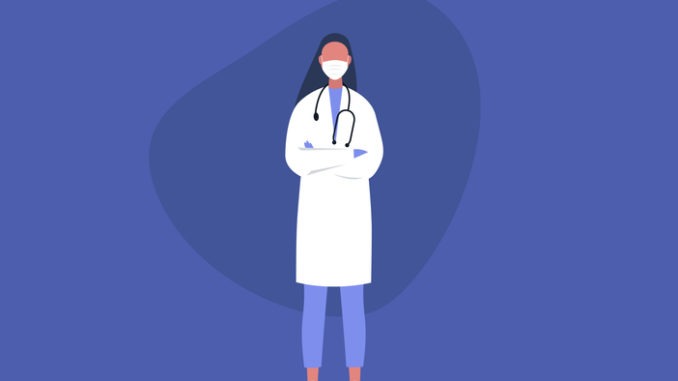
After a challenging year for general practitioners, Kathy Oxtoby examines how their role is developing, what these changes mean to them, and what being a GP could soon look like
CREDIT: This is an edited version of an article that originally appeared on The BMJ
COVID-19 telemedicine: what GPs have learned
“General practice is going through a paradigm shift around how we’re communicating with patients,” says Clare Gerada—London GP, chair of Doctors in Distress, and medical director of NHS Practitioner Health. Before the pandemic about 90% of GP consultations were face-to-face, and only a small proportion were done remotely. At the height of the pandemic this reversed, as around 70% of consultations were done remotely.
“The pendulum is now swinging back a bit, and practices are doing 55% of consultations face-to-face,” says Gerada. “However, I suspect we’re going to end up with 60% of all consultations starting and ending online.”
Preeti Shukla, a GP at the Richmond Hill Practice in Colne, Lancashire, says that this overnight shift to remote consultations brought a need for more training in telephone triage. Some patients, such as those who are deaf or have mental health issues, can find it difficult to communicate their stories remotely, she explains, and trainees, in particular, who have been taught face-to-face consultation skills, need to learn how to deal with patients’, often complex, needs over the ‘phone.
“Doctors didn’t train to work in call centres,” says Richard Vautrey, chair of the BMA’s General Practitioners Committee. “They want to have that regular, face-to-face interaction with their patients, which is one of the joys of general practice.”
For Gaurav Gupta, GP partner at Faversham Medical Practice and chair of Kent Local Medical Committee,, remote consultations come with “some ‘health warnings.’ “There is a risk that some populations – such as older people, or those for whom English is not their first language – who are digitally disadvantaged, might get poorer outcomes as a result of there being too much focus on remote consultations,” he says.
Impact of PCNs
As of the latest primary care network (PCN) sign-up in May 2020, all except a handful of general practices in England have come together in around 1,250 geographical networks covering populations of 30,000-50,000 patients, along with other healthcare staff and organisations, to provide integrated services to the local population.
Martin Marshall, chair of the Royal College of General Practitioners, says that PCNs “are what communities want” and that they will “help take general practice to a new level with a broader, skilled, multidisciplinary team, working to a large scale, and sharing staff.”
Vautrey adds that GPs need time to recruit, and that NHS England “isn’t giving much freedom as to who is recruited. What NHS England really needs to do is to trust us. We need greater flexibility in terms of the utilisation of the workforce so that we can make the best use of PCN funding.”
Grouping practices together in PCNs is “artificial” and “forced,” says David Turner, GP partner at Chorleywood Health Centre in Hertfordshire, who wants practices to have the freedom to spend money on front line roles. “What we want are more doctors and nurses.”
PCNs could potentially result in the end of the traditional partnership model.
“The old idea of being a partner within a practice will disappear,” Gerada says. “Instead, we will be equivalent to stakeholders within a PCN, whether that’s for profit as in a shareholder agreement or whether it’s a partnership as in a sort of consultant body – but that will be determined by the next generation of doctors.”
GP-patient relationships
Marshall told the 2020 RCGP conference that, during the COVID crisis, “many consultations have, by necessity, become more transactional, and this has reinforced the mistaken view of some people that general practice is largely a transactional medical specialty rather than a relational one.”
But GPs, he said, know that “the trusting relationship between a patient and a doctor—often, but not always, based on continuity of care—is the most effective intervention that we have at our disposal. It’s what helps us to use medications, investigations and specialist referrals appropriately and to reduce the risks of medicalising non-medical problems. It’s what encourages patients to engage with our advice, [and] it’s what many patients want from their GPs.”
Marshall told conference delegates that the COVID experience “has reinforced our decision to make the promotion of relationship-based care a strategic priority for the [RCGP].”
Gupta hopes that his practice will continue to provide a personal service to patients, as “that is the reason why most GPs have chosen to do this job. We are the only people in the healthcare system who have that relationship with patients and their families, and it would be a huge shame if that personal approach was lost.”
While Shukla likes the personal approach to care, she recognises that, even when “some sort of normality” comes into our lives again, remote consulting will continue, and a young population will want instant answers about their medicines and test results.
“We might not like the way care is heading, but we need to be aware of the demands of this younger patient population. They need us to change, and we will, with time. We always adapt; GPs are good at adapting,” she says.


Be the first to comment